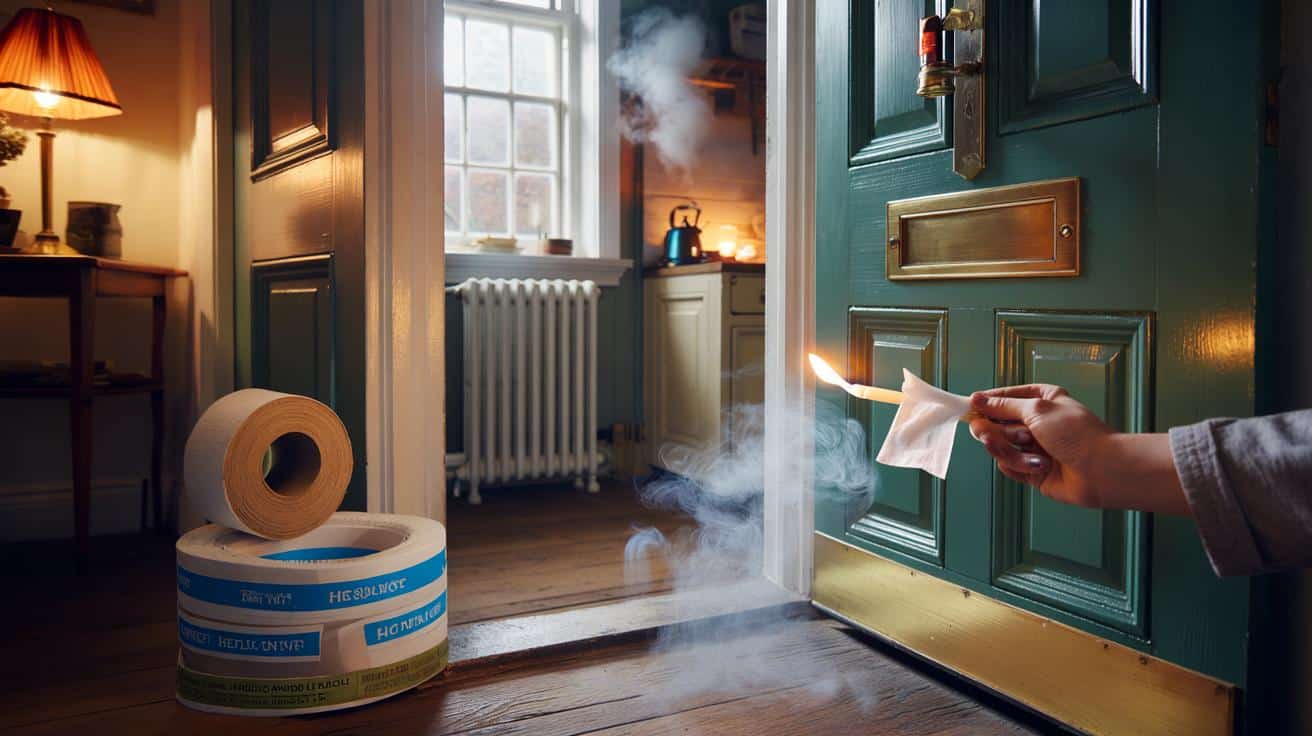The other night I watched the kitchen radiator tick itself silly while a thin ribbon of cold moved across the floor like a cat that knows every shortcut. The kettle steamed, the glass misted, and still my fingertips picked up a sneaky breeze under the back door, faint as a whisper. Somewhere, in a house that looks sealed and sensible, warm air was paying to leave early.
I put my hand to the letterbox and felt it again: the smallest flutter, as if the pavement outside was breathing in time with my boiler. I stood there and timed it with the extractor fan. Not a perfect test, but enough to make a point that bites in January. The money you think you’re spending on comfort is legging it down the path in a draught-shaped stream.
What else is slipping past you?
Where the heat goes when you’re not looking
Heat doesn’t vanish in dramatic bursts. It oozes out through hairline gaps, tired seals, and unwatched openings that seem harmless in daylight. Your fingers can map it, even before you fetch gadgets. Start at the places your eyes skip: under doors, around keyholes, along skirting boards, at the edges of loft hatches and old downlights.
Windows sell themselves as the culprits, yet a surprising share of wasted warmth wanders through ventilation pathways and small cracks. The stack effect does the rest, pulling warm air upstairs and out while dragging cold air in near the floor. That’s why your ankles complain first.
Picture a terrace in Bristol on a frosty morning. One roof keeps its frost longer than the next, and you know which loft is warmer than it should be. A family in the end house taped a floppy letterbox and plugged a gap under the lounge door with a rolled towel in under five minutes. Their living room went from “coat on” to “finally sit down” in a single evening. Not a miracle. Just physics you can feel.
Numbers tell a quieter story but the message is the same. Walls and roofs hold the big-ticket losses, yet uncontrolled draughts can add a steady tax on comfort all winter. A typical British home can claw back meaningful savings with simple fixes like brush seals, keyhole covers, and radiator tweaks. You don’t need a survey to find the first wins. You need twenty minutes and a curious hand.
Think of your house as a gentle pressure machine. Warm air rises and leaks from high points — loft hatch edges, Top-floor window frames, chimney throats — while cold air slides in low, through letterboxes, gaps under doors, and boards that have dried and shrunk. Close the high leaks and the low ones lose their pull. It’s a loop you can disrupt with small moves.
Your central heating works to fill those leaks the way a jug tries to top up a sieve. It’s tireless. It’s also expensive. Patch the sieve and the jug finally catches up.
Your 20‑minute heat‑loss check
Warm the house for ten minutes, then do a brisk circuit with the back of your hand, a thin tissue, and a candle or incense stick. Start at the front door: feel the letterbox, keyhole, and bottom edge; then window seals, trickle vents, and any extractor fan grilles. Walk the skirting, touch socket surrounds on external walls, check the loft hatch perimeter, and pause at any recessed lights that open into the loft. Watch the flame or smoke for flickers, and see if the tissue lifts at gaps.
We’ve all had that moment where a tiny draught makes the whole room feel mean. Don’t chase perfection in one go. Note the hotspots, especially where two materials meet — timber to brick, frame to plaster, pipe penetrations. If you rent, log what you find with photos by each area. Keep combustion vents and rooms with fuel-burning appliances clear for safety, and leave trickle vents partly open to manage moisture. Let’s be honest: nobody really does this every day.
**You can find 80% of your heat leaks with your hands, a candle, and a tissue.** Write quick labels on masking tape where you feel air movement so you can fix them later without hunting twice.
“People think they need a thermal camera,” says Joe, a heating engineer from Leeds. “Great if you have one, but your skin is a world‑class sensor. If your knuckles can feel it, your wallet can too.”
Use this rapid checklist while you walk:
- Front door: letterbox, keyhole, bottom seal, frame corners
- Ground-floor windows: corners, locks, trickle vents
- Floors and skirting: gaps, especially on external walls
- Radiators: cold spots, blocked fronts, and hidden behind sofas
- Loft hatch and upstairs lights: edges that breathe
- Chimney or disused flue: is it open to the sky?
What to do with what you found
Your notes are the map. Small fixes beat monster plans when you’re cold now. Brush seals for letterboxes and door bottoms tame the worst gusts in minutes. Keyhole covers are pocket change. A thick curtain or a draught snake at the front door shifts the whole hallway mood. Bleed radiators that sputter and move furniture away from them — heat needs space to roll across the room.
If you spotted a lively loft hatch, add compressible foam tape around the lip and insulate the hatch itself with a slab of board or a draped quilt until you buy proper insulation. A chimney balloon or temporary draught excluder tames a disused fireplace fast. Leave safe ventilation for gas appliances and rooms that need it; moisture management is part of warmth. **Most fixes cost less than a takeaway.**
Share what you found with a neighbour and compare notes. Patterns appear street by street — the same letterboxes, the same floorboard gaps, the same upstairs draughts where the wind hits the gable. A twenty‑minute circuit becomes a mini survey of how your place breathes. That’s not just thrift. It’s control, and it feels good in a way a thermostat never quite delivers.
| Key points | Detail | Reader Interest |
|---|---|---|
| Feel first, then fix | Back of hand, tissue, and a small flame reveal most leaks in minutes | Low cost, instant wins, tactile method |
| High leaks drive low draughts | Loft hatches, chimneys, and upstairs frames pull cold air in downstairs | Simple physics you can act on today |
| Small kit, big return | Brush seals, keyhole covers, foam tape, radiator bleed key | Affordable, quick to install, visible comfort boost |
FAQ :
- How can I feel draughts if the air is still?Warm the room for ten minutes, then use the back of your hand and a tissue. A flickering candle or incense smoke shows movement you can’t see.
- Is a thermal camera worth it?Handy, not essential. A cheap infrared thermometer helps for cold spots on walls and windows, yet your fingers find the biggest gaps first.
- Should I close trickle vents to stop all draughts?Keep some airflow to manage moisture and indoor air quality. Reduce harsh draughts at doors and gaps, not the safety ventilation.
- What about a disused fireplace or open flue?Use a removable chimney balloon or purpose-made excluder. Leave a tiny gap to avoid stagnation and remove it before any future use.
- I rent — what can I do without drilling or permission?Use draught snakes, temporary letterbox brushes, self-adhesive foam tape, thick curtains, and radiator foil. Photograph issues and share with your landlord.








